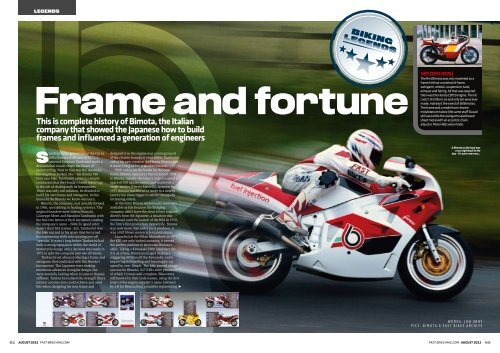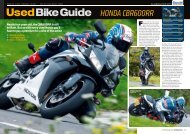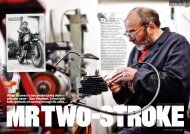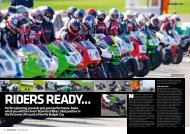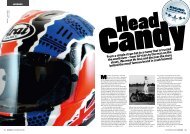The first Bimota was only marketed as a - Fast Bikes
The first Bimota was only marketed as a - Fast Bikes
The first Bimota was only marketed as a - Fast Bikes
Create successful ePaper yourself
Turn your PDF publications into a flip-book with our unique Google optimized e-Paper software.
Legends<br />
Frame and fortune<br />
This is complete history of <strong>Bimota</strong>, the Italian<br />
company that showed the Japanese how to build<br />
frames and influenced a generation of engineers<br />
Standing in the gravel trap at the Curva<br />
della Quercia at Misano in 1972, a<br />
battered M<strong>as</strong>simo Tamburini made a<br />
decision that would shape the future of<br />
motorcycling. Next to him <strong>w<strong>as</strong></strong> the re<strong>as</strong>on he<br />
nursing three broken ribs – his Honda 750<br />
Four race bike. Tamburini came to a simple<br />
conclusion that the Honda’s frame <strong>w<strong>as</strong></strong>n’t up<br />
to the job of dealing with its horsepower.<br />
<strong>The</strong>re <strong>w<strong>as</strong></strong> <strong>only</strong> one solution, he decided to<br />
build his own frame and swingarm. In this<br />
moment the <strong>Bimota</strong> we know <strong>w<strong>as</strong></strong> born.<br />
<strong>Bimota</strong>, the company, <strong>w<strong>as</strong></strong> actually formed<br />
in 1966, specialising in heating system s. <strong>The</strong><br />
original founders were Valerio Bianchi,<br />
Giuseppe Morri and M<strong>as</strong>simo Tamburini with<br />
the <strong>first</strong> two letters of their surnames creating<br />
the company’s name – BiMoTa (good job it<br />
<strong>w<strong>as</strong></strong>n’t their <strong>first</strong> names - Ed). Tamburini <strong>w<strong>as</strong></strong><br />
the bike nut and in his spare time he turned<br />
his engineering skills into creating one-off<br />
‘specials.’ It <strong>w<strong>as</strong></strong>n’t long before Tamburini had<br />
built a strong reputation within the world of<br />
motorcycle design and a decision <strong>w<strong>as</strong></strong> made in<br />
1972 to split the company into two divisions.<br />
Tamburini set about producing a frame and<br />
swingarm that could deal with the Honda’s<br />
horsepower. <strong>The</strong> Japanese were making<br />
enormous advances in engine design, but<br />
were woefully lacking when it came to ch<strong>as</strong>sis<br />
stiffness. Tamburini realised the strength that a<br />
tubular construction could achieve and used<br />
this when designing his new frame and<br />
designed it so the engine <strong>w<strong>as</strong></strong> an integral part<br />
of the ch<strong>as</strong>sis to make it even stiffer. Tamburini<br />
called his new creation the Honda-<strong>Bimota</strong> and<br />
it <strong>w<strong>as</strong></strong>n’t long before it sparked interest.<br />
With orders on the books for the new<br />
frame, <strong>Bimota</strong> opened its <strong>first</strong> factory in 1973<br />
in Rimini. Initially the factory <strong>only</strong> occupied a<br />
space of 100 square metres and employed a<br />
single worker (Dervis Macrelli), however by<br />
1975 <strong>Bimota</strong> <strong>w<strong>as</strong></strong> forced to move to a nearby<br />
factory ten times bigger to satisfy the rapidly<br />
incre<strong>as</strong>ing orders.<br />
At this time <strong>Bimota</strong> motorcycles were <strong>only</strong><br />
available <strong>as</strong> kits because the fledgling<br />
company didn’t have the clout to buy engines<br />
directly from the Japanese, a situation that<br />
continued until the launch of the KB1 in 1978,<br />
the firm’s <strong>first</strong> production motorcycle. <strong>Bimota</strong><br />
<strong>w<strong>as</strong></strong> now more than just a parts producer, it<br />
<strong>w<strong>as</strong></strong> a full blown motorcycle manufacturer.<br />
Launched at the Milan Motorshow in 1977,<br />
the KB1 not <strong>only</strong> looked stunning, it proved<br />
the perfect platform to showc<strong>as</strong>e <strong>Bimota</strong>’s<br />
skills. Taking a Ka<strong>w<strong>as</strong></strong>aki Z900 (and later the<br />
Z1) <strong>as</strong> a b<strong>as</strong>e, <strong>Bimota</strong> managed to chop a<br />
staggering 40 kilos off the Ka<strong>w<strong>as</strong></strong>aki, v<strong>as</strong>tly<br />
improving its handling and boosting its top<br />
speed by over 10mph. <strong>The</strong> bike proved a huge<br />
success for <strong>Bimota</strong>; 827 KB1s were produced<br />
of which 16 were sold complete. <strong>Bikes</strong> were<br />
still known by their code names, using the <strong>first</strong><br />
letter of the engine supplier’s name followed<br />
by a B for <strong>Bimota</strong> then a number representing •<br />
HB1 (1974-1975)<br />
<strong>The</strong> <strong>first</strong> <strong>Bimota</strong> <strong>w<strong>as</strong></strong> <strong>only</strong> <strong>marketed</strong> <strong>as</strong> a<br />
frame kit that consisted of frame,<br />
swingarm, wheels, suspension, tank,<br />
exhaust and fairing. All that <strong>w<strong>as</strong></strong> required<br />
then <strong>w<strong>as</strong></strong> the Honda CB750 engine. <strong>The</strong> kit<br />
costs 1.8 million Lire and <strong>only</strong> ten were ever<br />
made, making it the rarest of all <strong>Bimota</strong>s.<br />
<strong>The</strong> frame <strong>w<strong>as</strong></strong> a made from chrome<br />
molybdenum tubes (the same stuff Ducati<br />
still use) while the swingarm used boxed<br />
sheet metal with an eccentric chain<br />
adjustor. More HB2s were made.<br />
A <strong>Bimota</strong> on the hoof <strong>w<strong>as</strong></strong><br />
a rare sight back in the<br />
day – it’s even rarer now...<br />
W o r d s : J o n U r r y<br />
Pics: bimota & f<strong>as</strong>t bikes archive<br />
62 august 2011 f<strong>as</strong>t bikes mag.com<br />
f<strong>as</strong>t bikes mag.com august 2011 63
Legends<br />
bimota<br />
<strong>The</strong> brochures didn’t give you the price. If you had to <strong>as</strong>k, then you couldn’t afford one<br />
SB2 (1977-1978)<br />
<strong>The</strong> SB2 <strong>w<strong>as</strong></strong> the <strong>first</strong> street bike <strong>Bimota</strong><br />
produced and followed on from the track<br />
<strong>only</strong> SB1. Created at the request of Suzuki<br />
Italy <strong>only</strong> 200 frames were built and of this<br />
<strong>only</strong> 140 became motorcycles. As well <strong>as</strong> the<br />
tubular frame, the SB2 initially carried its<br />
fuel tank under the engine, lowering its<br />
centre of gravity to improve the handling,<br />
but this idea <strong>w<strong>as</strong></strong> abandoned for production<br />
after issues with heat dissipation. A<br />
complete SB2, using the Suzuki GS 750<br />
engine, cost 7.1 million Lire while a frame kit<br />
<strong>w<strong>as</strong></strong> 3.1 million Lire.<br />
At le<strong>as</strong>t the smoke here came<br />
from the rear tyre – too often<br />
it came from elsewhere...<br />
Well, what do you<br />
expect with a Suzuki<br />
TL1000R engine in it?<br />
<strong>Bimota</strong> branched out into Ducati engined<br />
bikes thanks to a former Ducati engineer<br />
Ride it or gawp at it.<br />
What would you do?<br />
Using the FZR1000 EXUP<br />
engine, the YB8 <strong>w<strong>as</strong></strong> a belter<br />
KB1 (1978-1982)<br />
<strong>The</strong> <strong>first</strong> Ka<strong>w<strong>as</strong></strong>aki-b<strong>as</strong>ed <strong>Bimota</strong> <strong>w<strong>as</strong></strong> a<br />
huge success with over 800 kits sold yet <strong>only</strong><br />
16 purch<strong>as</strong>ed <strong>as</strong> complete bikes. <strong>The</strong> frame<br />
fitted the Z900 and Z1 engine, depending on<br />
how much of a man you were. <strong>The</strong> tank <strong>w<strong>as</strong></strong><br />
made of pl<strong>as</strong>tic that <strong>w<strong>as</strong></strong> reinforced with<br />
fibregl<strong>as</strong>s while the wheels’ spokes were<br />
star shaped for strength – and coolness! A<br />
two seater version <strong>w<strong>as</strong></strong> available in 1980 that<br />
came with folding pillion pegs. A complete<br />
KB1 cost 7.6 million Lire while a kit <strong>w<strong>as</strong></strong> 3.2<br />
million Lire. An updated KB1-A <strong>w<strong>as</strong></strong><br />
launched with Marzocchi forks and a double<br />
Brembo front disc.<br />
<strong>The</strong> Tesi 1D <strong>w<strong>as</strong></strong> a<br />
work of art – but<br />
not a work of<br />
economics<br />
• the succession of models with that engine.<br />
Having built the <strong>first</strong> <strong>Bimota</strong> frames using<br />
tubular steel, Tamburini further developed his<br />
concept in the early 1980s and mated tubular<br />
frame rails to aluminium alloy plates around<br />
the swingarm area. Debuted on the KB3, this<br />
new concept <strong>w<strong>as</strong></strong> revolutionary and relied on<br />
the same engineering principles that are still<br />
used in modern superbikes. Tamburini<br />
understood that to create a ch<strong>as</strong>sis that didn’t<br />
flex, the are<strong>as</strong> of extreme stress needed to have<br />
the maximum amount of bracing, hence the<br />
use of aluminium plates.<br />
In March 1983 Tamburini decided to leave<br />
the company he helped found, citing personal<br />
re<strong>as</strong>ons for his departure. <strong>The</strong> loss of such a<br />
gifted designer, and the driving force behind<br />
<strong>Bimota</strong>, had a huge effect on the company,<br />
plunging it to near bankruptcy. Five months<br />
later former Ducati engineer Federico Martini<br />
provided the required direction. Joining<br />
<strong>Bimota</strong> <strong>as</strong> technical director he brought with<br />
him not <strong>only</strong> the contacts within the Ducati<br />
factory that would see the rise of the Ducati-<br />
<strong>Bimota</strong> models, but also a new concept in<br />
frame design – aluminium beam.<br />
In 1988 <strong>Bimota</strong> won the <strong>first</strong> ever<br />
world superbike race with Tardozzi ”<br />
Debuted on the YB4 in 1986, Martini’s<br />
aluminium beam frame <strong>w<strong>as</strong></strong> a world <strong>first</strong> for<br />
motorcycling. Having secured the supply of<br />
FZ750 engines from Yamaha, the YB4 replaced<br />
the tubular sections on Tamburini’s design<br />
with aluminium beams for extra strength. <strong>The</strong><br />
YB4, and the later YB4R and fuel injected YB4<br />
EI, put <strong>Bimota</strong> back on the map. At the hands<br />
of Virginio Ferrari the YB4R won several races<br />
in the 1987 TT F1 World Championship and in<br />
1988 it won the <strong>first</strong> ever world superbike race<br />
with Davide Tardozzi (records show Marco<br />
Lucchinelli <strong>as</strong> the winner <strong>as</strong> it <strong>w<strong>as</strong></strong> an<br />
aggregate result and Tardozzi fell off in the<br />
second race). <strong>Bimota</strong> nearly pulled off the<br />
unbelievable of defeating the mighty Japanese<br />
in the fledgling world series. Tardozzi led the<br />
series by 2.5 points going into the final round<br />
at New Zealand before a dis<strong>as</strong>trous second<br />
race saw him fall, surrendering the title to<br />
DB1 (1985-1986)<br />
<strong>The</strong> <strong>first</strong> <strong>Bimota</strong> built entirely in Italy used a<br />
Ducati Pantah 750 engine and <strong>w<strong>as</strong></strong> the <strong>first</strong><br />
bike produced after the departure of<br />
M<strong>as</strong>simo Tamburini. <strong>The</strong> weird fairing<br />
design <strong>w<strong>as</strong></strong> to allow for greater steering lock.<br />
Oddly enough, 75 per cent of the 453 DB1s<br />
made were sold to the Japanese market. <strong>The</strong><br />
bike cost 15.870 million Lire.<br />
Tesi (1983 onwards)<br />
<strong>Bimota</strong>’s longest serving model h<strong>as</strong> been<br />
through more than its fare share of facelifts<br />
and engine swaps, but the b<strong>as</strong>ic design is<br />
still the same. <strong>The</strong> prototype, which <strong>w<strong>as</strong></strong><br />
unveiled at the Milan bike show in 1983, even<br />
had its indicators incorporated into its<br />
fairing. After five prototypes (some which<br />
were raced) the Tesi finally made it into<br />
production in 1990 using a Ducati 851 engine.<br />
Honda rider Fred Merkel. But the race success<br />
had achieved its goal, <strong>Bimota</strong> <strong>w<strong>as</strong></strong> now an<br />
international brand.<br />
Having stolen the ch<strong>as</strong>sis march on the<br />
Japanese in the 1970s, by the mid-1980s the<br />
‘Big Four’ had caught up and <strong>Bimota</strong> needed a<br />
new way of distinguishing its products from<br />
m<strong>as</strong>s produced bikes. Having contacted<br />
<strong>Bimota</strong> in the early 1980s, Pier Luigi Marconi<br />
and Roberto Ugolini produced a thesis on a<br />
revolutionary new design of motorcycle front<br />
wheel. Using an oscillating swingarm the<br />
university students eliminated the use of<br />
conventional forks and created a front wheel<br />
that steered via a hub, splitting the steering<br />
and shock absorption functions of the wheel<br />
to improve rider feel. <strong>The</strong> project <strong>w<strong>as</strong></strong> named<br />
Tesi (short for thesis) and after initial<br />
prototypes the Tesi 1D 851 <strong>w<strong>as</strong></strong> launched in<br />
1990, using Ducati’s 851 V-twin engine. But<br />
the Tesi failed to catch the public’s imagination<br />
and the decade saw <strong>Bimota</strong> adopt a different<br />
commercial strategy with the emph<strong>as</strong>is on<br />
developing a range of models.<br />
This new strategy <strong>w<strong>as</strong></strong> the brain child of<br />
Walter Martini in 1993. Martini embarked on<br />
an ambitious expansion programme and<br />
between 1993 and 1994 managed to double<br />
<strong>Bimota</strong>’s production from 600 to 1200 units a<br />
Engineering marvels they<br />
may be, but all <strong>Bimota</strong>s are<br />
made for riding hard<br />
year. Further expansion <strong>w<strong>as</strong></strong> achieved though<br />
the creation of new models that brought<br />
<strong>Bimota</strong> into previously unexplored are<strong>as</strong> such<br />
<strong>as</strong> the 1995 Mantra and Supermono. Alongside<br />
these European-engined models, <strong>Bimota</strong><br />
continued to collaborate extensively with the<br />
Japanese manufacturers. <strong>The</strong> 1994 SB6, which<br />
used the GSX-R1100 engine, proved <strong>Bimota</strong>’s<br />
most successful ever model, selling 1100 units,<br />
and <strong>w<strong>as</strong></strong> soon joined in the range in 1997 by<br />
the higher spec SB6R. <strong>The</strong> YB9 <strong>w<strong>as</strong></strong> created in<br />
1996 using a Yamaha 598cc engine from an<br />
FZ600 to appeal to younger riders. <strong>The</strong>n came<br />
<strong>Bimota</strong>’s most adventurous project yet, not<br />
<strong>only</strong> a new bike but it’s own motor.<br />
Having cancelled the Tesi project, Martini<br />
directed funds towards developing what <strong>w<strong>as</strong></strong><br />
to be <strong>Bimota</strong>’s jewel in its crown – the Vdue, a<br />
two-stroke 500cc bike that <strong>w<strong>as</strong></strong> going to be the<br />
alternative to large capacity four strokes. A<br />
decision that brought <strong>Bimota</strong> to its knees…<br />
Launched in 1997 the Vdue <strong>w<strong>as</strong></strong> a dis<strong>as</strong>ter.<br />
Not <strong>only</strong> <strong>w<strong>as</strong></strong> the V-twin underpowered, the<br />
fuel injection <strong>w<strong>as</strong></strong> horrific. Rather than a<br />
showc<strong>as</strong>e of <strong>Bimota</strong>’s m<strong>as</strong>tery, the Vdue <strong>only</strong><br />
served to besmirch <strong>Bimota</strong>’s reputation.<br />
Owners who were expecting a 500 GP bike<br />
with lights and mirrors were left frustrated and<br />
many returned their bikes, demanding a •<br />
64 august 2011 f<strong>as</strong>t bikes mag.com<br />
f<strong>as</strong>t bikes mag.com august 2011 65
Legends<br />
BD3 Mantra 900<br />
(1995-1998)<br />
Once seen, never forgotten! <strong>Bimota</strong>’s <strong>first</strong><br />
naked bike <strong>w<strong>as</strong></strong> met with a fair degree of<br />
scepticism due to its odd looks and odder<br />
name, which translated <strong>as</strong> ‘tool of thought.’<br />
<strong>The</strong> performance of the Ducati Monster 900<br />
engine <strong>w<strong>as</strong></strong> OK, the walnut d<strong>as</strong>h possibly a<br />
step too far…<br />
Vdue (1997-1999)<br />
<strong>The</strong> bike that finally broke <strong>Bimota</strong> <strong>w<strong>as</strong></strong><br />
destined to be great. A two-stroke V-twin<br />
500cc that looked glorious and sounded<br />
even better. When it <strong>w<strong>as</strong></strong> running, anyway.<br />
<strong>The</strong> truth <strong>w<strong>as</strong></strong> horrific fuel injection, dodgy<br />
build quality and nowhere near the 110bhp<br />
<strong>Bimota</strong> promised. <strong>The</strong>n there <strong>w<strong>as</strong></strong> the price<br />
tag, a cool 32.560 million Lire. Bang went<br />
the Vdue, pop went <strong>Bimota</strong>.<br />
• refund. <strong>The</strong> whole incident proved too<br />
much. Having gone bust, <strong>Bimota</strong> became<br />
<strong>Bimota</strong> Motor SpA in November 1998 with a<br />
new management team and a new philosophy.<br />
<strong>The</strong> company would stick with what it knew<br />
best – producing innovative motorcycles in<br />
limited numbers for niche markets.<br />
<strong>The</strong> <strong>first</strong> bike to appear under this<br />
philosophy <strong>w<strong>as</strong></strong> the SB8R. Using Suzuki’s<br />
TL1000 V-twin engine, the SB8R built on<br />
<strong>Bimota</strong>’s knowledge of carbon fibre gained<br />
through the 1997 SB6R. Where the SB6R h<strong>as</strong> a<br />
carbon self-supporting seat unit, the SB8R<br />
took this one stage further and incorporated<br />
carbon into the bike’s frame, a <strong>first</strong> for<br />
motorcycle production. While the engineering<br />
benefits of this system are dubious, the SB8R<br />
proved the point that <strong>Bimota</strong> <strong>w<strong>as</strong></strong> back and put<br />
the Vdue debacle behind the company.<br />
Suzuki had originally developed the<br />
TL1000R <strong>as</strong> a ‘Ducati beater’ in world<br />
superbikes, but it never actually raced. <strong>The</strong><br />
<strong>Bimota</strong> <strong>w<strong>as</strong></strong> different. To everyone’s surprise at<br />
the 2000 WSB round in Australia the SB8R<br />
won the <strong>first</strong> race, thanks in no small part to<br />
the skill of legendary loony Anthony Gobert.<br />
<strong>The</strong> rest of the se<strong>as</strong>on <strong>w<strong>as</strong></strong> equally <strong>as</strong><br />
memorable, but for the wrong re<strong>as</strong>ons. <strong>The</strong><br />
<strong>Bimota</strong> blew up spectacularly at the next<br />
round in Japan and the team subsequently<br />
withdrew from the rest of the series.<br />
With the new millennium came (yet<br />
another) management change and 2003 saw<br />
<strong>The</strong> SB6 is now an<br />
affordable entry<br />
into <strong>Bimota</strong> world<br />
Not all <strong>Bimota</strong>s were instant<br />
beauties, like this YB8 in black<br />
I own one<br />
“Before you consider owning a <strong>Bimota</strong><br />
you have to understand the company’s<br />
philosophy. You’re buying into their<br />
t<strong>as</strong>te, which may not suit everyone. <strong>The</strong><br />
suspension and fuelling is seldom sorted<br />
before they leave the factory so you’ll<br />
need to get the bike set up correctly. This<br />
transforms any <strong>Bimota</strong>. I know spending<br />
money after buying a <strong>Bimota</strong> may be<br />
tricky, but it’s worth going the extra mile<br />
to improve one. <strong>The</strong> more effort you put<br />
in, the more you will love your <strong>Bimota</strong>.<br />
<strong>The</strong> stories of unreliability are not true<br />
(leaving out the Vdue, but even these<br />
can be made to work). If maintained<br />
correctly <strong>Bimota</strong>’s are reliable, the<br />
biggest problem is getting someone to<br />
work on them. Many franchised dealers<br />
will not take on a <strong>Bimota</strong> service. Get a<br />
good technician who understands<br />
<strong>Bimota</strong>s and most, if not all, of your<br />
problems will disappear.<br />
People <strong>as</strong>k me why they should buy a<br />
<strong>Bimota</strong> – and which one. I tell them not<br />
to buy one unless they really want one.<br />
As it says on our website – decide on the<br />
model you want and stick with it.<br />
Remember the one that you want may<br />
not be to everyone’s liking, but it is to<br />
yours and that’s all that matters.<br />
<strong>Bimota</strong> is <strong>only</strong> an alternative to what is<br />
available, albeit a very good one, and in<br />
this world where we all search to be<br />
ourselves, owning a <strong>Bimota</strong> is a chance<br />
to be an individual.”<br />
Glen – <strong>Bimota</strong>-enthusi<strong>as</strong>ts.com<br />
new management. <strong>The</strong> current crop of <strong>Bimota</strong><br />
motorcycles have been created using Ducati<br />
engines, most recently the 1100 air-cooled<br />
engine from the Multistrada in the DB5 and<br />
DB6, and the 1098 motor in the DB7 and the<br />
1198 in the DB8. <strong>The</strong> Tesi project h<strong>as</strong><br />
re-emerged in the shape of the Tesi 3D while<br />
the Honda CBR600RR powered HB4 is<br />
scheduled to be rele<strong>as</strong>ed <strong>as</strong> a trackday bike<br />
b<strong>as</strong>ed on the firm’s Moto2 racer. Considering<br />
the economic climate and decline in sportsbike<br />
sales is there still a future for a small producer<br />
of exotic and high end motorcycles? That’s<br />
another story all together… •<br />
In race form, the SB8R won<br />
a wSB race. Just the one,<br />
mind...<br />
66 august 2011 f<strong>as</strong>t bikes mag.com


